2023.08.04.68
Files > Volume 8 > Vol 8 no 4 2023
Role of Irrigation Scheduling and Potassium Levels on the Growth and Yield of Rice (Oryza sativa L.) Anbar 33 cultivar
Ahmed Al-Mashhadani1,
Saad Hassan2, Muntadher Al_Budeiri 3, *, Ali Matar4
1 Agriculture
Research Office / Ministry of Agriculture/ Baghdad/ Iraq. a[email protected].
2 Agriculture
Research Office / Ministry of Agriculture/ Baghdad/ Iraq. [email protected].
* Correspondence:
[email protected].
Available from.
http://dx.doi.org/10.21931/RB/2023.08.04.68
ABSTRACT
A field
experiment was carried out in the Agricultural Research Office fields / Al
Diwaniyah Research Station in 2019 to study the role of irrigation scheduling
and potassium levels in the Growth and yield of rice (Oryza sativa L.)
Anbar 33 cultivar. A Factorial experiment Design in order of split plot with
three replicates was used, the main plots occupied with irrigation factor (I)
with four levels I1, I2, I3 and I4 representing irrigation every (1,2,3 and 4
days respectively), while the subplots occupied with potassium fertilizer
factor (K) with four levels K1, K2, K3 and K4 representing (0, 60, 120 and 180
Kg k ha-1 respectively). The Results indicated that the Irrigation
scheduling affected Growth and yield traits
where
I2 treatment was significantly superior in
plant height, panicle length, panicle number, the weight of 1000 grains, grain
yield and biological yield, which gave 97.3cm, 23.42cm,
100.8m2, 17.77gm, 2.86Meg ha-1 and 10.00 Meg ha-1
respectively, which did not different
significantly of I1 treatment on plant height, panicle length, panicles number,
grain yield and biological yield. The addition of potassium fertilizer
significantly affected the studied traits, as K2 was significantly superior on
panicle number, grain number/panicle, grain yield and biological yield, which
gave 101.9m2, 60.58, 2.94 Mgh-1 and 9.69 Mgh-1,
respectively, which did not different
significantly than K4 treatment on panicles number, grain number/panicle and
grain yield.
The interaction indicated that there were
significant differences among treatments, as I2K2 was significantly superior on
panicle number, grain number/panicle, grain yield and biological yield, which
gave 160.0m2, 55.00, 4.20Meg ha-1 and 13.63Meg ha-1,
respectively.
Keywords. Potassium
fertilizer;
Irrigation role; Drought
tolerance Rice.
INTRODUCTION
Rice (Oryza sativa L.) is the most
widely consumed staple food for the world's population, particularly in Asia 1.
Asia ranks first in terms of production and consumption of rice, according to
the report of the Food and Agriculture Organization (2016). The average
production of rice is estimated at 5.0 * 108 tons, and due to the
high population, the requirements are expected to increase to 2.0 * 109
tons by 2030. The
current and projected global sustenance requires a significant increase in crop
yields in less favorable rainfed lands. Climate change, which affects the
regularity and level of hydrological fluctuations, is a significant threat to
agriculture, especially in developing countries, and causes various abiotic
stresses 2. Among the abiotic factors that led to plant evolution,
drought is the most essential and significant limit to rice production in
rainfed ecosystems 3;
4. Agriculturally, a
drought is a period with lower average rainfall/weak precipitation or higher
evaporation due to deteriorating crops 5. The severity of drought is very complex
and depends on various causes, such as the frequency of rainfall, evaporation
and soil 6; 7. Elements such as nitrogen (N), phosphorus (P) and
potassium (K) are the most essential nutrients for plant growth and development
8, 9. Higher
vegetable fabrics typically contain about 1.5% N, 0.2% P, and 1.0% K (10).
Plant growth requires large amounts of these macronutrients 11. Oversupply of nitrogen, phosphorous and
potassium in crop production systems has increased yield over the past decades.
However, the overuse of chemical fertilizers has seriously damaged the
environment by boosting greenhouse gas levels and promoting eutrophication due
to fertilizer exploitation's low efficiency 12,13, 14.
Therefore, maintaining nutritional balance
and enhancing fertilizer efficiency is essential to reduce the use of
fertilizers in crop and nutrition production systems that protect the
environment 15. K is not covalently attached to organic molecules.
However, it is the most abundant cellular cation, regulating stomatal motility,
osmotic adaptation, charge homeostasis, steady state enzyme activation,
transmembrane potential, and transmembrane protein 16, 17. The K+
ion is used as the main solute to maintain turgor and induce irreversible
changes in cell size. It also plays an essential role in many metabolic
processes. The circulation of K+ in the phloem acts as a form of
decentralized energy storage that can bypass local energy limits 18.
This study focuses on rice's drought tolerance at the best potassium fertilizer
level.
MATERIALS AND METHODS
The experiment was performed at Al
Diwaniyah Research Station, Agricultural Research Office/ Ministry of
Agriculture. The seeds were sown on June 25, 2019. The soil was plowed
permanently, And the process of leveling and smoothing was carried out, after
which the plots of land were prepared, and the area was divided into
experimental units. Anbar33 was soundly direct seeding in plots (3*3m2)
at the amount of (140 kg seeds ha-1). As stripes between a line and
another 20 cm, the area of each experimental unit was 9m2 (3mx3m).
Mineral fertilizers were added as DAP (Di Ammonium Phosphate) 200 kgP h-1
was added before planting to provide the phosphorous element, and 280 kgN h-1
urea was added to supply the nitrogen element, twice, the first one after
planting, the second after a month from the first. The deals were randomly
distributed according to the Randomized Complete Block Design (RCBD) in an
order of split plots with three replicates.
The main plots occupied the irrigation
factor (I) with four levels: -
1.
I1: - irrigation every day.
2.
I2: - irrigation every two days.
3.
I3: - irrigation every three days.
4.
I4: - irrigation every four days.
Potassium fertilizer factor (K) as
potassium sulfate (K2SO4) added twice with urea, filled
subplots with four levels: -
1. K1:
- added 0kgKha-1.
2. K2:
- added 60kgKha-1.
3. K3:
- added 120kgKha-1.
4. K4:
- added 180kgKha-1.
The plants were collected on December 1,
2019, randomly sampled from each experimental unit to measure plant growth and
yield properties.
Number of experimental units = 3 * 4 * 3 =
36 units.
RESULTS
Plant high
The
results showed in Table (1) a significant difference in irrigation scheduling,
where the I2 treatment was significantly superior in plant height compared to
the I3 treatment, with an increased ratio of 11.96%, Which did not differ
significantly from the I1 treatment. The table results indicated no significant
effect when potassium fertilizer levels were added between the experimental
treatments. The results indicated statistically significant differences between
interaction levels, as treatment of I1K4 was significantly superior to
treatment of I4K1, with an increase ratio of 48.62%.
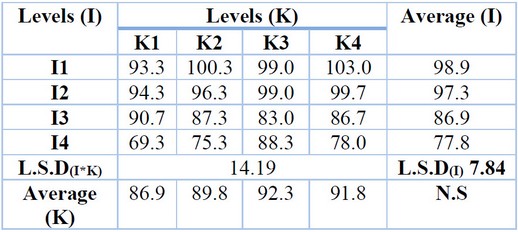
Table 1. Irrigation scheduling role and potassium levels on Plant high (cm)
Panicle length
The results showed in Table (32) a
significant difference in irrigation scheduling, where the I2 treatment was
significantly superior in panicle length compared to the I3 treatment, with an
increased sed ratio of 8.53%, significantly different from the I1 treatment.
The Table showed no significant impact when potassium fertilizer levels were
added between the experimental treatments. The results indicated statistically
significant differences between interaction levels, as treatment of I2K4 was
significantly superior to treatment of I4K1, with an increase ratio of 15.04%.
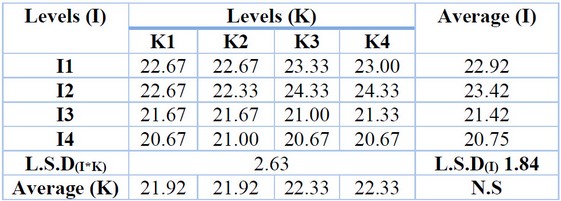
Table 2. Irrigation scheduling role and potassium levels on panicle length (cm)
Panicles number
The
results are shown in Table) a significant difference in irrigation scheduling,
where the I2 treatment was significantly superior in panicle number compared to
the I4 treatment, with an increased ratio of 32.11%, Which did not differ
significantly from the I1 and I3 treatments. The results of the taTablendicated
a significant effect between the experimental treatments when potassium fertilizer
levels were, as the K2 treatment was significantly superior to the K1 treatment
with an increase of 18.21%, Which did not differ significantly from the K4
treatment. The results indicated statistically significant differences between
interaction levels, as treatment I2K2 was significantly superior to treatment
I4K1, with an increased ratio of 46.25%, Which did not significantly differ
from the I3K4 treatment.
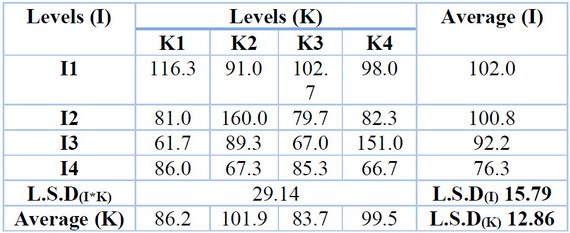
Table 3. Irrigation scheduling role and potassium levels in panicles number (m2).
Grain number/panicle
The
results are shown in Table) a significant difference in irrigation scheduling,
where the I1 treatment was significantly superior in Grain number/panicle
compared to the I4 treatment, with an increased ratio of 24.38%, Which did not
differ significantly from the I3 treatment. This Table indicates a significant
impact between the experimental treatments when potassium fertilizer levels
were, as the K2 treatment was significantly superior to the K1 treatment with
an increase of 18%, Which did not differ significantly from the K4 treatment.
The results indicated statistically significant differences between interaction
levels, as treatment I2K4 was significantly superior to treatment I4K1, with an
increased ratio of 45.5%, Which did not significantly differ from the I3K4
treatment.
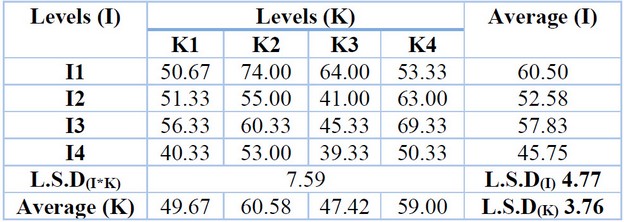
Table 4. Irrigation scheduling role
and potassium levels on Grain number/panicle
Weight of 1000 grain
The
results in Table) showed a significant difference in irrigation scheduling,
where I2 treatment was significantly superior in weight of 1000 grains compared
to I4 treatment, with an increased ratio of 12.15%. Table 5 indicates no
significant impact between the experimental treatments when potassium
fertilizer levels. The results indicated statistically significant differences
between interaction levels, as treatment I2K3 was significantly superior to
treatment I3K3, with an increased ratio of 25.34%.
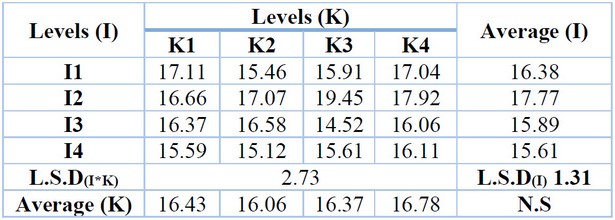
Table 5. Irrigation scheduling role and potassium levels on weight of 1000 grain
(gm)
Sterility percentage
The
results are shown in Table) There was no significant impact on irrigation
scheduling. The results of the taTablendicated showed a significant effect
between the experimental treatments; when pota potassium fertilizer levels were
added, the K4 treatment was significantly superior to the K3 treatment with a
decrease of 31%, Which significantly differed from the K2 treatment. The
results indicated statistically significant differences between interaction
levels, as treatment I3K2 was significantly superior to treatment I4K1, with a
decrease ratio of 56.75%.
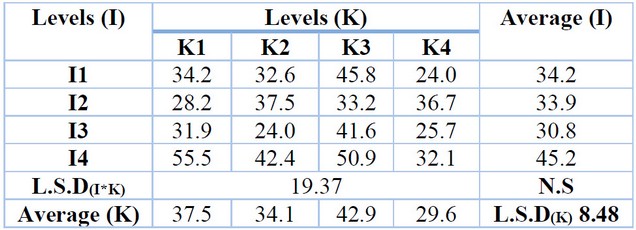
Table 6. Irrigation scheduling role and potassium levels on sterility percentage
(%)
Grain yield
The
results showed in Table (7) a significant difference in irrigation scheduling,
where the I2 treatment was significantly superior in Grain yield compared to
the I4 treatment, with an increased ratio of 66.27%, Which did not differ
significantly from the I1 treatment. The taTablendicated results showed a
significant effect between the experimental treatments when potassium
fertilizer levels were added, as the K2 treatment was significantly superior to
the K1 treatment with an increase of 45.54%. The results indicated
statistically significant differences between interaction levels, as treatment
I2K2 was significantly superior to treatment I3K1, with an increased ratio of
236%.
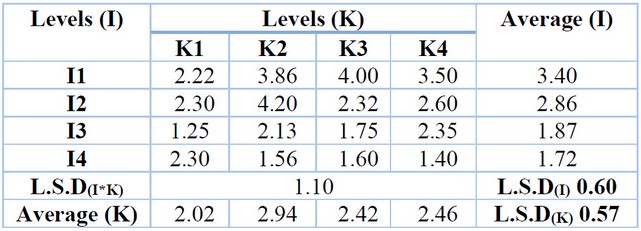
Table 7. Irrigation scheduling role
and potassium levels on Grain yield (Meg ha-1)
Biological yield
The
results are shown in Table) a significant difference in irrigation scheduling,
where the I2 treatment was significantly superior in biological yield compared
to the I4 treatment, with an increased ratio of 50.82%, Which did not differ substantially
from the I1 treatment. This indicates a significant effect between the
experimental treatments when potassium fertilizer levels were, as the K2
treatment was significantly superior to the K1 treatment with an increase of
20.97%. The results indicated statistically significant differences between
interaction levels, as treatment I2K2 was significantly superior to treatment
I4K4, with an increased ratio of 153.81%, Which did not significantly differ
from the I1K3 treatment.
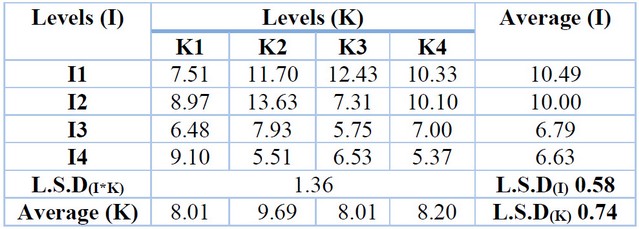
Table 8. Irrigation scheduling role and potassium levels on biological yield (Meg ha-1).
DISCUSSION
The results indicate that there
was a significant effect of irrigation scheduling and the addition of different
levels of potassium on Growth and yield of rice (Anbar 33 cultivar), as the
level of I2 was significantly superior in both grain and biological yields, and
this is due to its superiority in plant height, panicle length, panicles number, and weight 1000 grain, as
well as it was not significantly different from I1 in grain yield, biological
yield, plant height and panicles number. The tables also showed that the
K2 level was significantly superior to the grain yield and the biological yield due to its superiority in panicle number and grain number/ panicle. It did
not differ significantly from the K4 level in grain yield, panicle number
and the grain number/ panicle. This may be because the irrigation intervals in
the field allow for good ventilation and the increase in the activity of
microorganisms, which led to the formation of active and healthy roots, which
encourages the absorption of nutrients, including potassium, which was
reflected in an increase in panicles number and weight of 1000 grain, this agrees with 19, 20. 21. The
interaction results also showed the superiority of I2K2 treatment in grain
yield and biological yield due to its superiority in panicle number and the
grain number/panicle. This led to the choice of I2 because it reserved 50% of
irrigation water. To obtain good Growth and yield of rice cultivar anbar 33,
with the level K2 that achieved the best results, the reason may be that
irrigation every two days stimulated the level 60Kg K ha-1 to be better and saved 50% of the
fertilizer recommendation.
CONCLUSION
Irrigation scheduling significantly affected the Growth and
yield of rice, with the I2 treatment (irrigation every 2 days) showing superior
results in plant height, panicle length, panicle number, weight of 1000 grains,
grain yield, and biological yield. The addition of potassium fertilizer also significantly
impacted the studied traits, with the K2 treatment (added 60 kg K ha-1) showing
superior results in panicle number, grain number/panicle, grain yield, and
biological yield. The interaction between irrigation scheduling and potassium
levels also showed significant differences, with the I2K2 treatment (irrigation
every 2 days and added 60 kg K ha-1) showing superior results in panicle
number, grain number/panicle, grain yield, and biological yield. The results
indicated that the K4 treatment (added 180 kg K ha-1) was significantly
superior to the K3 treatment (added 120 kg K ha-1) in grain yield. The I2
treatment (irrigation every 2 days) was significantly superior to the I4
treatment (irrigation every 4 days) regarding grain yield.
Author
Contributions: Conceptualization, Al-Mashhadani A. and Hassan S.; methodology, Hassan S.
and Matar A.; software, Al-Mashhadani A. and Al_Budeiri M.; formal analysis,
Al_Budeiri M.; investigation, Al-Mashhadani A. and Al_Budeiri M.; resources,
Al_Budeiri M.; data curation, Al_Budeiri M.; writing—original draft
preparation, Al-Mashhadani A. and Al_Budeiri M.; writing—review and editing,
Al-Mashhadani A. and Hassan S.; supervision, Al-Mashhadani A. and Hassan S.;
project administration, Al-Mashhadani A. All authors have read and agree to the
published version of the manuscript.
Funding: This research received no external funding.
Conflicts of Interest: The authors declare no conflict of interest.
REFERENCES
1. Samal R, Roy P S, Sahoo A, Kar M K, Patra B C, Marndi B C,
Gundimeda J N R. 2018. Morphological and molecular dissection of wild
rice from eastern India suggests distinct speciation between O. rufipogon and
O. nivara populations. Sci Rep, 8(1): 2773.
2. Turral H, Burke J J, Faurès J M. 2011. Climate Change,
Water and Food Security. Rome, Italy: (FAO).
3. Nelson G C, Valin H, Sands R D, Havlík P, Ahammad H, Deryng D,
Elliott J, Fujimori S, Hasegawa T, Heyhoe E, Kyle P, Lampe M V, Lotze-Campen H,
d’Croz D M, van Meijl H, van der Mensbrugghe D, Muller C, Popp A, Robertson R,
Robinson S, Schmid E, Schmitz C, Tabeau A, Willenbockel D. 2014. Climate
change effects on agriculture: Economic responses to biophysical shocks. Proc
Natl Acad Sci USA, 111(9): 3274–3279.
4. Pandey V, Shukla A. 2015. Acclimation and tolerance
strategies of rice under drought stress. Rice Sci, 22(4): 147–161.
5. Rollins J A, Habte E, Templer S E, Colby T, Schmidt J, von
Korff M. 2013. Leaf proteome alterations in the context of physiological
and morphological responses to drought and heat stress in barley (Hordeum
vulgare L.). J Exp Bot, 64(11): 3201–3212.
6. Hao Z C, Singh V P, Xia Y L. 2018.
Seasonal drought prediction: Advances, challenges, and
prospects. Rev Geophys, 56(1): 108–141.
7. Elkhateeb, S. Z.; Ebraheem, M. O.; Abdulateef, S. M.; Ahmed,
I. A. Constraints Affecting the Welfare of Domestic Sheep Grazing in the
Natural Pasture. IOP Conf Ser Earth Environ Sci 2023, 1252 (1), 12144. https://doi.org/10.1088/1755-1315/1252/1/012144.
8. Al-Fadhal FA, AL-Abedy AN, Alkhafije DA.
Isolation and molecular identification of Rhizoctonia solani and Fusarium
solani isolated from cucumber (Cucumis sativus L.) and their control
feasibility by Pseudomonas fluorescens and Bacillus subtilis.
Egyptian Journal of Biological Pest Control. 2019 Dec;29:1-1.
9. Wang Y, Chen Y F, Wu W H. 2021. Potassium and
phosphorus transport and signaling in plants. JIPB, 63(1): 34-52.
10. K. kudury, S., A. Abed, I., A. Mahdii, B. Microbial
Fertilizers Existence And Its Relationship To Heavy Metals In Some Sustainable
Agricultural Fields In Anbar Governorate. Anbar Journal of Agricultural
Sciences, 2023; 21(1): 44-53. doi: 10.32649/ajas.2023.179714.
11. Ali, H.H., AL-Rawi, K., Khalaf, Y., Alaaraji, S., Aldahham,
B., Awad, M., Al-ani, O., Al-ani, F., Ali, A.T.Serum Caveolin-1 Level is
Inversely Associated with Serum Vaspin, Visfatin, and HbA1c in Newly Diagnosed
Men with Type-2 Diabetes.Reports of Biochemistry and Molecular Biology,2022, 11
(2), pp. 299-309.
12. Jebur, S. F.; Abdulateef, S. M. Effect
of The Critical Period and Gene Silencing on Blood Cellular Traits in Local
Chicken and Level of Welfare. IOP Conf Ser Earth Environ Sci 2023, 1252 (1),
12141. https://doi.org/10.1088/1755-1315/1252/1/012141 .
13. Al-Fadhal, F.A., AL-Abedy, A.N. and Alkhafije,
D.A., 2019. Isolation and molecular identification of Rhizoctonia
solani and Fusarium solani isolated from cucumber (Cucumis
sativus L.) and their control feasibility by Pseudomonas fluorescens
and Bacillus subtilis. Egyptian Journal of Biological Pest Control, 29,
pp.1-11.
14. A A Al-Azzami , Th T Mohammed . Effect of Adding Dry Leaves of
Lemongrass (Cymbopogon citratus) To the Diet on Some Biochemical Tests of Blood
in Broiler (Ross 308). IOP Conference Series: Earth and Environmental
Science.2023, 1252(1) ,012125. https://doi.org/10.1088/1755-1315/1252/1/012125.
15. Tang X G, Xie J S, Xu C X, Liu J, Yuan F S, Liu G R, Li Z Z. 2021.
Effects of Chinese milk vetch and reduced chemical fertilizer application on
quality and nutrient uptake of early rice in red soil paddy field. CJRS, 35(5):
466-474. (in Chinese with English abstract).
16. Khudai M Y, Abdulateef S M, Mouhammed T Th, Alamili H S. Use
of modern geometric design of fish ponds to increase welfare and blood
parameters. Revis Bionatura 2023;8 (2) 82.
http://dx.doi.org/10.21931/RB/2023.08.02.82.
17. Ameen M. Shaman , Th. T. Mohammed. Effect Using Feed Additives
Instead of Imported Premixes Affects the Physiology of Broiler Chickens. IOP
Conference Series: Earth and Environmental Science.2023, 1262(7), 072080. https://doi.org/10.1088/1755-1315/1262/7/072080.
18. Torrance L, Cowan GH, McLean K, MacFarlane S,
Al-Abedy AN, Armstrong M, Lim TY, Hein I, Bryan GJ. Natural resistance to
Potato virus Y in Solanum tuberosum Group Phureja. Theoretical and Applied
Genetics. 2020 Mar;133:967-80.
19.
Al-Atijawi, S. H. .; Almusawy, R. S.
. The Effect Of Adding Different Rates Of Mushroom
Powder To The Wheat Flour On The Nutritional Value Of Proteins, Sensory And
Physical Properties Of Local Bread. JLSAR 2021, 2, 46–53
20. Al-Zubaidy, N. .; Al-Mubarak, N. F. .;
Ahmed, A. M. . The Effect Of Fertilization And Repeated Mowing On Some
Vegetative Characteristics And Yield Of Panicum Mombasa Plant. JLSAR 2021, 2,
34–45.
21. A A Al-Azzami , Th T Mohammed . The Effect of Adding
Lemongrass Leaf Powder (Cymbopogon Citratus) to the Diet as a Natural
Supplement on Some Productive Traits and Oxidation Indicators in Broiler (Ross
308). IOP Conference Series: Earth and Environmental Science.2023, 1252(1)
,012123. https://doi.org/10.1088/1755-1315/1252/1/012123.
22. Kashkol, H. R., R. K. AL-Jubouri, and A. Sh. al-Mashhadani.
2013. Effect of periods irrigation in the Growth and holds two types of rice
effect. IJAS, 0.5 (4): 416-425.
Received:
September 26 2022 / Accepted: April 15 2023 / Published:15 December 2023
Citation: Al-Mashhadani, Ahmed.; Hassan, Saad.; Al_Budeiri, Muntadher.; Matar, Ali. Role of Irrigation Scheduling and
Potassium Levels on the Growth and yield of Rice (Oryza sativa L.) Anbar 33
cultivar. Revis Bionatura 2023;8 (4) 68.
http://dx.doi.org/10.21931/RB/2023.08.04.68
Publisher's Note: Bionatura stays neutral concerning jurisdictional claims in
published maps and institutional affiliations.
Copyright: © 2023 by the authors. Submitted for possible open-access publication
under the terms and conditions of the Creative Commons Attribution (CC BY)
license (https://creativecommons.org/licenses/by/4.0/).
